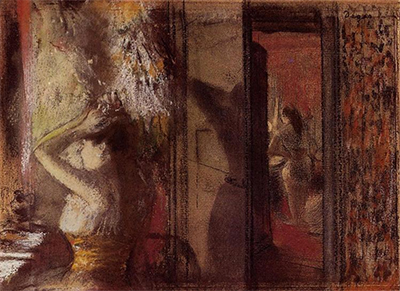 Buy Art Prints Now
Buy Art Prints Nowfrom Amazon
* As an Amazon Associate, and partner with Google Adsense and Ezoic, I earn from qualifying purchases.
The artwork The Actresses Dressing Room pays tribute to Degas' love for theatre as he brings the viewer into the dressing room before the show. These behind the scene artworks that Degas created most likely stem from his active imagination pondering what goes on behind the curtain before the show.
As it is evident through the artist's work, Degas adored portraying the female figure through actresses, ballerinas, and dancers of all sorts. As this art form was a popular within the French culture at the time, Degas also enjoyed part-taking in it by depicting them in his work. While it was still the onset of the artist's painting career in the late 17th century, he would continue his fascination with theatre into his artwork. One of the artist's most popular artworks is his painting Blue Dancers, where the artist showcases ballerina dresses in beautiful blue French tutus. The formation of these ballerina's was a focal point in the artist's career where he began experimenting with composition in his work.
The female figure within the artwork is most likely a ballerina, based on her attire. While only the top half of her costume is shown within the artwork, it seems to resemble the classic costumes ballerinas wore at the time. With a ruffled white top that hugs the breasts of the woman, the outfit begins to transform downwards into a gold fabric that hugs the stomach tightly to create the illusion of a small waist. This style of costume was incredibly common as it reflected corsets everyday women would wear at the time. While the viewer isn’t able to truly get a glimpse of the bottom of her costume, it seems as if it ruffles into a romantic tutu. The woman is seated in front of a vanity looking into what seems like a large mirror with some type of lighting hitting her face. The theatrical woman has her hands above her head fixing her hair before going on stage.
The woman's long brown hair disappears behind her as it mixes into the shaded background. The viewer is able to get a side profile of the woman, starring into the mirror to fix her hair. While Degas did not create the artwork with an ample amount of detail, he does showcase her pointy nose and small dark eyes. The woman seems to be seated at a vanity, with paint brushes and makeup on the table. While Degas was so immensely consumed with the female embodiment within theatre, he never depicted the application of make up within his artwork. Rather, Degas decided to stick to illustrating women fixing their hair, putting on their costumes, or bathing.
At the onset of the artist's career, Edgar Degas had created an immense number of pastel and oil pieces that showcases women bathing. Some of these works include After The Bath, Seated Bather, and Woman Having Her Hair Combed. Degas was immensely captivated by this private activity that his imagination created endless amounts of pieces showcasing his idea of what occurs when no one is watching. This idea is similarly instilled in The Actresses Dressing Room, and all of the other behind the scene artwork Degas has created. To the right of the painting, the viewer is able to see another woman preparing to go on stage. She too is wearing a gold wrap that hugs her waist to create a constraint within her body. The room is coloured in burgundy hues that Degas achieved through the use of pastels.




